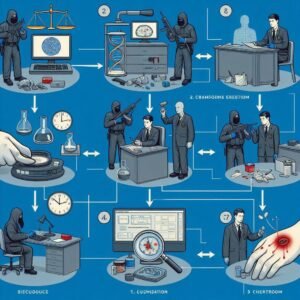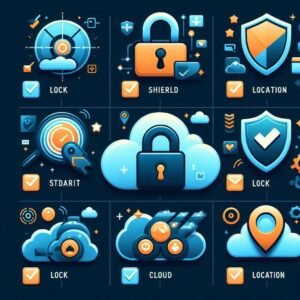Digital Arrest
How Law Enforcement, Technology, and Your Data Collide

Introduction: Here is what matters
Digital tools changed how crimes are solved. They also changed how arrests happen. Today, a single message, a location ping, or a cloud backup can be the difference between freedom and custody. That’s the essence of digital arrest: when digital information or technology directly leads to a person being identified, located, and detained by law enforcement.
Let me explain what digital arrest actually looks like, why it matters to you, what rights apply, and simple steps to reduce the chances that your devices become the instrument of your arrest. Bottom line: your data is evidence. Treat it like it can be used against you.
What is a digital arrest?
A digital arrest occurs when law enforcement uses digital sources phones, apps, social media, GPS logs, CCTV, Internet of Things devices, cloud storage, or metadata to identify, locate or accuse someone of a crime. It is not a special type of arrest in the legal code. It is a practical description of the evidence chain that started with electronic data rather than a physical witness or forensic trace like fingerprints.
Here are common ways digital evidence triggers an arrest:
-
Location data from a phone or vehicle showing presence at a crime scene.
-
Messaging app logs or emails that suggest planning or intent.
-
Photos or videos uploaded to social media showing criminal acts.
-
Metadata from digital files proving timelines.
-
Smart device logs (like doorbell cameras or smart locks) that record activity.
Why digital arrest is different and why you should care
Digital evidence has a few properties that make it powerful and risky.
First, scale. Devices collect vast amounts of data automatically. A phone tracks locations, calls, texts, app usage, and more. That means investigators can reconstruct behavior in surprising detail.
Second, persistence. Unlike a witness who forgets, many digital records are preserved for months or years in backups or cloud systems.
Third, transitivity. Data from one source can implicate others. For example, a social media post can be matched with CCTV footage and location pings to create a strong case.
Fourth, ambiguity. Digital traces can be misinterpreted. A geolocation ping near a crime scene doesn’t prove participation. That ambiguity matters when your freedom is at stake.

Typical scenarios that lead to digital arrests
Understanding patterns helps you protect yourself.
-
Social media as confession. Posting images or boasting messages can be direct evidence. People get arrested for photos, live videos, or posts that reveal criminal acts or weapons.
-
Location and movement. Investigators use cell tower data, Wi-Fi logs, and GPS to place people at relevant times. A phone’s location history is a common puzzle piece.
-
Messaging and planning. Texts, chats, and emails that mention plans, times, or roles in wrongdoing are straightforward evidence.
-
Cloud backups and deleted files. Deleting a photo or message isn’t guaranteed to remove it. Backups and server logs often preserve content.
-
Device forensic recovery. Even when data is deleted on-device, forensic tools can often recover fragments that point to activity or intent.
Legal safeguards and rights you should know
Legal protections vary by country, but some principles are common.
Right to privacy. Many jurisdictions protect personal data and communications. However, courts often allow search warrants for digital data if there is probable cause.
Warrants and subpoenas. Law enforcement usually needs a warrant to access data on your private devices or cloud accounts. Subpoenas and court orders can compel providers to hand over metadata, which is often easier to obtain.
Consent and third-party data. If someone else consents to search your device or shares your data, that can be used against you. Also, service providers may retain logs and comply with lawful requests.
Right to counsel. If you are questioned, you have the right to an attorney. This is critical when digital evidence and technical questions can be confusing.
Let me be blunt: legal protections are real but complicated. If you face an investigation, contact a lawyer who understands digital evidence immediately.
Common myths and straight answers
Myth: Deleting a message deletes the evidence.
Fact: Often false. Copies, backups, and third-party logs frequently remain.
Myth: Encryption makes me untouchable.
Fact: Encryption raises the bar but does not make you immune. Lawful access, device seizure, and operational mistakes can defeat it.
Myth: If I didn’t send the message, I can’t be blamed.
Fact: Accounts can be spoofed or shared. Ownership and access patterns still get investigated.
Myth: Only criminals need to worry.
Fact: Innocent people get investigated all the time. Mistaken identity, ambiguous data, and sloppy investigative conclusions can bring you into the legal system.
Practical steps to reduce your risk
You don’t need to become a security researcher. Do these sensible things.
-
Manage social content. Think before posting. Avoid real-time geo-tags when you’re at private places or with sensitive groups. Keep profiles private where possible.
-
Limit unnecessary location sharing. Turn off constant location history in services you don’t need. Review app permissions regularly.
-
Use device security. Lock phones and laptops with strong passcodes. Enable full-disk encryption and update software to patch known vulnerabilities.
-
Be careful with cloud backups. If you must store sensitive information, use end-to-end encrypted services or local backups. Understand provider data retention.
-
Separate personal and risky behavior. If you are engaging in controversial but legal activities, keep details minimal on public platforms.
-
Record only what you need. Avoid unnecessary recordings that could be misinterpreted later.
-
If approached by police, exercise your rights. Ask if you are free to leave. If not, ask for a lawyer. Do not consent to device searches without legal advice.
Digital forensics in plain language
When police seize a device, they typically follow a forensics process:
-
Preserve the device state. They make a bit-for-bit copy to avoid changing evidence.
-
Extract data using forensic tools. This includes active files, deleted files, logs, and metadata.
-
Analyze patterns. Investigators reconstruct timelines, connections, and possible motives.
-
Correlate sources. Phone data, CCTV, and online activity are cross-checked for consistency.
-
Document findings for court. Reports explain methods and limitations.
Understanding this process helps you appreciate why a small digital trace can have an oversized impact.

When digital evidence is wrong challenges and defenses
Digital evidence is powerful but not infallible. Good defenses expose weaknesses.
Chain of custody. If the data handling is sloppy unclear who accessed files or when credibility weakens.
Attribution problems. Proving a device was controlled by a specific person at a specific time is not always straightforward.
Context matters. A message or a photo can be taken out of context. Defense lawyers often present alternative explanations.
Technical errors. Tools make mistakes. Analysts can misconfigure software or misinterpret logs. Independent expert review may reveal errors.
If you’re in a legal case, an experienced digital forensics expert and lawyer can challenge how data was collected and interpreted. Don’t assume the presence of data equals proof beyond reasonable doubt.
Broader societal implications – a quick look
Digital arrest raises public questions that deserve attention.
Privacy versus safety. Society wants effective law enforcement, but unchecked access to digital records risks mass surveillance.
Power asymmetry. Corporations control much of the data. Their policies and responses to law enforcement requests shape outcomes.
Policy and oversight. Courts and legislatures must keep pace. Clear rules about retention, access, and oversight reduce abuse.
Digital literacy. Citizens need practical knowledge to protect themselves. Awareness reduces both unintended risks and unjust outcomes.
Quick checklist – what to do today

Here’s an actionable list you can use now.
-
Review app permissions and disable unnecessary location sharing.
-
Remove public geotags from social posts.
-
Use a passcode and enable device encryption.
-
Turn on automatic updates.
-
Use strong, unique passwords and enable two-factor authentication.
-
Back up your data privately or use encrypted backups.
-
If approached by police, say you want a lawyer before answering questions or consenting to searches.
Final words bottom line

Digital arrest is not a sci-fi phrase. It’s how data your data moves from everyday behavior to courtroom evidence. That reality cuts both ways. Data helps solve crimes and, when mishandled, can wrongly convict. Know how digital evidence works. Protect your devices. Know your rights. If you ever face investigation, talk to a lawyer who understands digital forensics.

Pingback: डिजिटल अरेस्ट क्या है